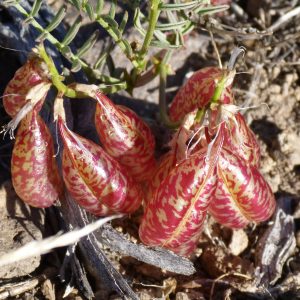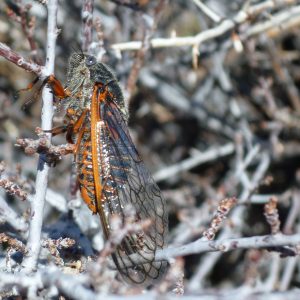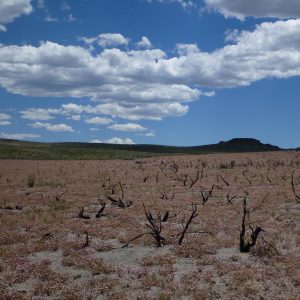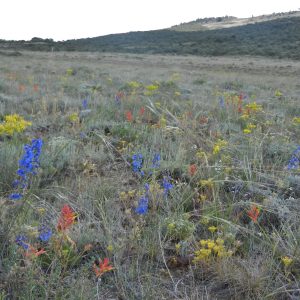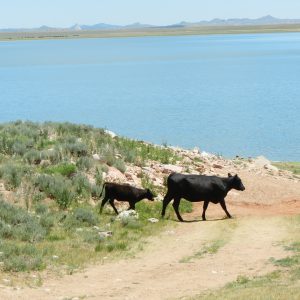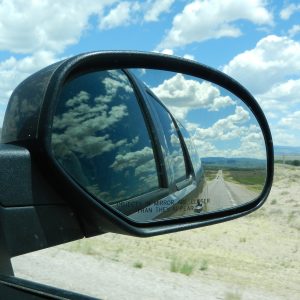 So far, my adventure with the Conservation and Land Management internship has been exciting to say the least. After leaving the workshop at the Chicago Botanic Gardens Friday night, I only made it a few hours before totaling my car. Around 9:30pm I had an unfortunate encounter with a deer on interstate 88 near the border or Illinois and Iowa. Long story short, my car ended up 150+ feet from the side of the road and I was still 1300+ miles (over 20 driving hours) from my destination. With a lot of help from relatives, strangers, and my coworker Zack, I was able to make it to Escalante, Utah and in time for my first day.
So far, my adventure with the Conservation and Land Management internship has been exciting to say the least. After leaving the workshop at the Chicago Botanic Gardens Friday night, I only made it a few hours before totaling my car. Around 9:30pm I had an unfortunate encounter with a deer on interstate 88 near the border or Illinois and Iowa. Long story short, my car ended up 150+ feet from the side of the road and I was still 1300+ miles (over 20 driving hours) from my destination. With a lot of help from relatives, strangers, and my coworker Zack, I was able to make it to Escalante, Utah and in time for my first day.
The first week of work really revealed what my partner and I had gotten ourselves into, the position is driving intensive to say the least (something I didn’t take out of the interview). The Escalante Grand Staircase National Monument spans nearly 1.9 million acres and it’s our job to find important plant species to eventually make seed collections from. Don’t get me wrong, I really don’t mind having to drive so far each day, I really love the scenery; even when we’re driving through unbearably hot desert-like areas, I still find it beautiful. Sometimes the roads are pretty rough, we’re lucky to have such a large work truck otherwise I doubt we could make it. Sometimes the roads are paved, sometimes not, sometimes you’re on the edge of a mesa and the two-way road is barely more than one lane wide and you have a wall to your left and a sheer drop off to your right. I live for those roads, they’re exciting and terrifying all at once.
In terms of botanizing and plant identifying, the experience has been incredible. Back home in NY, this is part of what I do for fun, I know I’m not cool but I’m lucky to have nerdy friends that like the same thing. Often for me, the recreation and exercise of hiking is secondary to identifying plants, birds, fungi, etc. It’s great to be forced to do it for part of the job. Of course, identification is really as far as we take it for most species in the field, but when we get out of work, I get to studying the plants further, including associates, etymology and anything else I find interesting. I’ve really felt that pay off when I get back to work the next day. Knowing the Latin really helps you connect with the plants in an interesting way. A lot of the time the general and specific epithets are pretty descriptive if you know what they mean, and since I’ve never been to Utah before, I tend to learn what names mean before I actually get to see the plant in person. Finally seeing the plant and realizing why it’s named the way it is, really makes for a fascinating moment. Learning characteristics of plant families and having a good base knowledge in etymology is a great mechanism to identifying plants in the field you’ve never seen before, and it works no matter where you live.
I think this internship is a really great opportunity to study what you love in a place you’re not familiar with. It’s a rare opportunity, and I’ve been lucky enough to experience it twice. I went to school in New York, took an intensive field ecology course in the Florida Everglades during my last semester, and now I get to work across the country on the Colorado Plateau. Each experience so far has been so unique, but at least when I came home from the Everglades I was mysteriously a bit more knowledgeable about ecology in New York. I’m excited to see how 5 months here pays off back home, and I already feel like it will a great deal. I’m sure I won’t live in NY forever, but I know a broad range of experiences in different environments will pay off anywhere I end up.
To wrap up, I’d like to add that I don’t mind not having a car here in Escalante, sure it limits me to areas that are within biking distance but there’s so much to see right in and outside of town that I may have overlooked had I had a car here with me. I’ve had a great first month and am looking forward to what the next 4 will bring.
Daily Archives: 8 July, 2013
The Thunder Rolls
In the past week here in Carson, lightening and thunder storms have become more frequent. It looks like an average sunny day. Hot, no clouds, and birds singing. Without much warning, a storm can come in and be on top of you within minutes. Dark angry looking clouds appear. The wind picks up and the birds disappear. A little bit of rain is scattered throughout. Then the lightening and thunder starts. Sounds exciting but when you have a metal clipboard in hand or are carrying a metal optical device, it is a different story. There was a range specialist in our office that once told us “when it rains, there will be fire!” This is from the high number of lightening strikes that will hit ground within one storm.
Our crew was out on an average day doing AIM transects. Birds were singing and the sun was blazing! Within half an hour the clouds, wind, and droplets of rain had arrived. We heard some thunder still at a distance and decided to head to the trucks. As we all piled in, the storm was straight overhead. Long streaks of lightening and huge claps of thunder. We waited for over an hour before the storm passed. During that time, a large storm chasing firefighter truck passed us to go to a vantage point to look for fires started by lightening. Luckily that storm did not start any fires nearby. If that had been the case it could have been a dangerous situation for us.
I have experienced thunder storms before, but never this intense. Usually I am already inside and watching the storm safe and sound. Here in Nevada, with a field job, these storms can be dangerous if actions are not taken immediately. It is an experience new to me and one that I will never forget.
Hot Hot Heat!
It’s kind of crazy to think that in the past month of working out here in the desert, a field day in 107 degrees weather is really not that bad and is much more preferable than working out in 120 degrees of dry heat. My focus in life right now is to avoid heat stroke! Since coming back from the fabulous workshop in Chicago, Emily and I have teamed up with one of the wildlife biologists in our office to help assess riparian areas by running MIMs, assist with Yellow-billed Cuckoo surveys, and increase our skills in evaluating rangeland health and plant utilization. Unfortunately, I missed out on a wet/dry mapping event at the Agua Fria River due to being sick, which definitely increased my West Nile paranoia from my massive mosquito bites in Chicago! Although my health has gotten better, the drought in Arizona has not. It seems to be getting worse year after year and it has got me looking forward to the monsoon season.
We’ve got a crazy schedule planned out for the next 2 weeks trying to finish up our transects so that the rangeland health evaluations (RHE) can be written up on schedule! Since our mentor has been called out to help with the fires occurring in northern AZ, we want to be as up to date as possible for when he returns.
My thoughts go out to the 19 Granite Mountain Hotshots who lost their lives in the Yarnell Hill fire.
Passing the halfway point
Hard to believe I’ve already finished the first half of my internship, but as I filled out my timesheet this week, I noticed that I had just hit the 440 hour mark. I guess time flies when you’re out in the field all the time! June and July are definitely crunch-time for our office, and the race is on to collect seed, monitor fire plots and characterize sage grouse nesting sites before everything with chlorophyll in it is turned into crispy, unidentifiable remnants. On the plus side, this means I’m out in some pretty cool places almost every day.
One of my favorites, oddly enough, is the Indian fire, a 13,000 acre burn in the hills just south of Mono Lake. It must have been a dense shrubland at one point, but after the burn and without any plants to hold down the soil in the big winds off the lake, it has been turned into a sculpted dunsescape. The only trace of the shrubs, and even the fire, is in the ghostly, twisted stems of bitterbrush, charred by the blaze and smoothed by the wind-driven bits sand. However, even in this desolation, the plants have come back strong, with carpets of annual wildflowers, perennial grasses and even resprouts from fire-adapted shrubs. One of the annuals, Phacelia bicolor, is so thick in spots that from a distance entire hillside seem pink! Its pretty crazy to me that a seed weighing maybe 1/100 of a gram can turn into a sprawling plant the size of a plate in only a few months, and all in one of the driest years on record! Makes me feel better when my entire seed collection won’t even fill a sandwich bag.
Another fun little tidbit from the last few weeks was a Cicada hatch! I didn’t even know California had cicadas, but for a week or so the air was filled with the buzzing and clumsy flights of big orange bugs, doing whatever it is that cicadas do in their brief time above ground. I thought it was pretty cool, and I’m sure the birds and other insectivores were pretty happy as well! Anyhow, I’m looking forward to the second half of my internship, and even more so now that I have a fellow intern to work with!
Signing off,
Bridger
Reading, reading, reading
It’s crazy to think it’s already July and that the Chicago trip was three weeks ago. I hope everyone had a great 4th of July and to those who were just beginning their internship after the training, that they’re settling in well.
My current work for the CLM Internship program is developing a lit review to support my project looking at post-fire vegetation recovery over long-term periods using remote sensing. For anyone not familiar with remote sensing, on the broadest level, it just means collecting information about something using an instrument that does not have physical contact with what you’re studying. It could be acquiring aerial photography from a plane or imagery from a satellite, but it could also apply to the medical field using x-rays to get an image of a broken leg. For my internship, I’ll be sticking to whatever is free of cost and publicly available — so primarily satellite imagery.
Right now I’m sifting through a lot of articles. My computer screen is often drowned in the number of tabs open because one article leads to another article which leads to another. To help break up the monotony of articles, I’m also cataloging websites that have vegetation data which may be useful further down the line. Below is an image of one of the more common land cover products, the National Land Cover Database – 2006, produced through the work of a consortium of 10 government agencies.

“National Land Cover Database.” USGS Publications. Feb. 2012 <http://pubs.usgs.gov/fs/2012/3020/fs2012-3020.pdf>
Big Thicket 2-month update
This week wraps up nearly 2 months as an intern at Big Thicket, Texas. The last 4 weeks began with a trip to Chicago for a weeklong workshop at the Botanic Garden, where I had a great time meeting all the other CLM interns and enjoying the cool, comfortable Chicago weather. Back in the Thicket, I’ve been continuing to work on updating the All-Taxa Biodiversity Inventory (ATBI) by organizing spreadsheets and creating maps of species locations. But, I’ve also seen a healthy portion of fieldwork. With our office’s spiffy Garmin Montana 600 series GPS, part of my job is to journey into the Thicket to obtain geographic information to map. On one such quest, I discovered a dried-up tupelo bog whose presence had been long-suspected, but never confirmed. Last week, I made a trail map for the Watson Preserve, a local, privately owned rare plant preserve.
The ATBI is dependent on specialists visiting the preserve to do species collections so they can accurately tally species of all orders, including all types of animals, plants, and fungi. Two weeks ago, researchers from the University of Nebraska came here to do collections of nematodes. We took them to three different units of the preserve to get soil samples, which they took back and will analyze under a microscope to count the number and species diversity of nematodes.
Outside of work, I have been trying to explore the surrounding area as much as possible. I went to nearby New Orleans, LA, a few weekends ago to take in the jazz music and consume copious amounts of catfish, crawfish, shrimp, beignets, and po boys. I’ve also fallen in with a cycling club in Beaumont, TX that I’ve been riding with on the weekends.
Later,
Alex, Big Thicket NP
Here are some pictures:
Continuiing projects at Pine Hill Preserve
The weather has been getting progressively hotter here in California’s Central Valley and Sierra foothills. The triple digit temperatures this week make it hard for me to believe that last week it rained and I was craving hot soup, while helping with a trash clean up day.
Julie and I have reached our Seeds of Success seed collection goal for this season, and we may collect a few more if there is a good opportunity. We have also wrapped up the first stage of our fuel break burn pile monitoring. We examined each of several hundred burn piles and noted dominant species and whether or not any of the Pine Hill Preserve rare plants have germinated. Although this was tedious, it gave me a lot of practice with seedling identification. Seedlings often look quite different than their mature counterparts and by looking at them over and over again I was able to deduce what many of them were. This ended up being significant because towards the end I realized that two types of seedlings that were fairly abundant were in fact rare plants!

Ceanothus roderickii seedling, a federally listed species, sprouting in a burn pile
One of them, Crocanthemum suffretescens, appeared by the hundreds in the charcoal of the burn piles. This species has been the focus of another project. It is recognized by the California Native Plant Society as rare, but is not even recognized as being a distinct species in the new Jepson manual. A new version of A Flora of North America is being written in which this plant is recognized, but El Dorado County has not been included the description. All of this raises some questions for us at Pine Hill Preserve. What plant do we have? Does it fit established keys? Is it rare? etc. We have taken samples from several locations, made measurements, taken photos, and compared them to the key in A Flora of North America. We are fairly certain we have suffretescens but there is enough variability to raise some doubt. It might seem like a small issue but there are practical ramifications. If a plant is listed as rare, it completely changes what can legally be done to its habitat, including development.
In any case, rare or not, many plants have responded well to the fuel break construction and burning. My mentor, Graciela, often talks about implementing larger scale prescribed burns over entire parcels of the preserve. I couldn’t agree more when I look at the contrast between the mature chaparral and the fuel break. The chaparral appears overly dense, senescent, and loaded with fuel waiting to burn. A thick layer of manzanita leaves has inhibited the growth of other plants, including all of the rare plants. The fuel break and burn piles, on the other hand, are full of a high diversity of herbaceous forbs, grasses, and rare plants. However, looking the opposite direction to the other side of the wildland-urban interface, I see houses. These houses are upslope of what is essentially a huge tinderbox, especially during a year as dry as this one. As my own home burned down in a wildfire several years ago, I would understand any anxiety from these homeowners about a prescribed burn so close to them. Either way, ultimately the chaparral is highly adapted to fire and will most likely burn at some point. The controlled conditions of a prescribed burn are no doubt safer, and I hope Graciela is able to approve them.
This week has been too hot for field work except in the early morning, so I have been working on projects inside. Hopefully the delta breeze will return and it will cool down soon!
Joe Broberg
Pine Hill Preserve
BLM Mother Lode Field Office
El Dorado Hills, CA
Greetings from Wyoming!
Greetings from Wyoming!
I have been here in Laramie a little over a week, and after unpacking (mostly) and watching the first of many summer hailstorms on the Laramie Plain, I am finally settling in. The transition has been a whirlwind: in two weeks I packed and moved from my New Mexico archaeology gig to botanizing in southeast Wyoming. I just missed the training in Chicago, and after a few days in the field, I took up the leadership role for the SOS team. Won’t say that I never missed a beat (still missing them—if you find them, let me know), but I couldn’t be more pleased. Laramie is a solid western community with college town flair, and as for the landscape, it was love at first sight. Of course, reliable sources tell me that July is Wyoming’s one pleasant month of the year. I’ll keep you posted.
This internship’s primary goal is getting seed collections for the Seeds of Success program. This means that my job is to hike, camp, and look at plants all summer—so what am I supposed to do for fun?! Write blogs, I suppose, and maybe catch some live music in the park for the Fourth of July. So far we’ve been scouting and collecting on the Laramie Plains, down to the grasslands of northern Colorado, up to the Powder River Basin, and high up the Snowy Range today for a change of pace. The wildflower display is fantastic, and sometimes it’s hard to remember it’s the seeds we want. Right, seeds. Less pretty, more useful.
Still learning, and hopefully will get better as time goes on. You can be jealous now, or just enjoy your own CLM experiences. Happy summer!
Cheers, Abby D.
- Wyoming goes crazy
- That’s right.
Gearhart Mountain Wilderness Adventures
Most of this past month of work has been dedicated to monitoring bull trout populations in the Gearhart Mountain Wilderness in eastern Oregon. The Bull trout is a threatened species and we have been electroshocking to capture them in the streams and gathering data on them such as length and weight. We have also been tagging all of this fish that we catch with PIT tags so that we can monitor demographic parameters of the population as well as how far individuals travel within a stream. This effort has been aided by antennas that pick up the PIT tags in the fish as they travel upstream or downstream.
So far this has been my favorite field work as the environment is ideal, especially in hot weather and electroshocking is a very exciting and fun process. You have to be on your toes and ready to capture the fish once they are temporarily stunned from the electroshocking, which has made for many fun and entertaining memories! Bull trout are also an appealing species with beautiful coloration containing cream colored to bright orange spots. It has been a great time to work out in small forested streams with very intact riparian areas which creates the complex habitat that bull trout require to compete and thrive. There has also been restoration work done on some of the streams to see if it increases bull trout numbers and decreases competing fish populations such as the invasive brown trout. The restoration consists of putting large woody debris into the streams to create more pools, riffles, cut-banks and cover for the bull trout. It will be interesting to put the data together from this year and previous years to try and find a trend and to see how far the bull trout are traveling within the stream!


Bird is the word
To properly assess the presence of avian species in a particular area, it is important to be present during their period of greatest activity. Birds are most active after they wake; diurnal birds in the early morning, nocturnal birds at night. Diurnal birds hidden amongst riparian greenery singing in chorus of increasing, frantic volume as soft, warm hues emerge over the east hills. The nocturnal nighthawks and poorwills (goatsuckers, affectionately), looping above the sagebrush in fading purple light, erratically snatching a buggy breakfast mid-flight. I have learned, a wildlife biologist must make the decision, sometimes concession, to relinquish the comfort of routine in pursuit of good data.
And no, I am not complaining in the least. This is what I came for.
Well, to be honest, the only thing I knew I was coming for was experience, the experience as a wildlife intern with the BLM, and everything which accompanies.
The real show is getting’ going and it looks something like this: Sage Grouse habitat assessment (sagebrush transects) served ‘quick and dirty. Raptor monitoring in two proposed project areas, one riparian rehabilitation, the other bicycle trail construction. These projects will be the figurative (field experience) and literal (my livelihood) moneymakers. That being said, my schedule is anything but set in place. There are plenty of hours in the week to lend a (hopefully) helping hand to fellow employees who we can be of service. Examples recently have included various bird surveys with a biologist, invasive plant species removal and rangeland vegetation data collection.
*insert something here about the oppressively sweltering heat wave*
An integral event which took place since the last time we spoke was the week-long CLM training workshop in the Chicago area. I’m sure you’ve heard a lot about it by now, so I won’t bore you with the details…But realtalk, it was a pleasure to meet all the people who make the program what it is,both staff and current interns. I went into the workshop with a natural curiosity towards hearing the thoughts and experiences of those who, I thought, were in a similar internship position as myself. What I came to learn was that I am one of the few with a focus in wildlife, amidst interns mostly participating in Seeds of Success. I found this surprising and wonder how I might view my internship experience differently if I were not in the position I am in. And perhaps most important during the training (kind of kidding), I was able to sample Chicago’s contributions to the culinary world during my first time in the city; deep-dish pizza and the real-deal hot dog.
But seriously, this heat is just silly, and I shouldn’t even be allowed to complain at 5,500’.
-Jake

